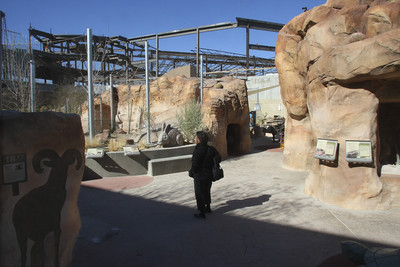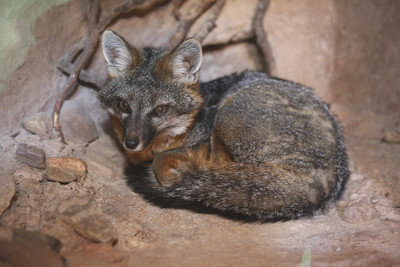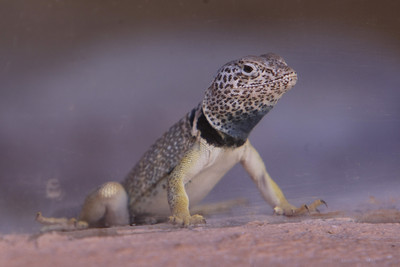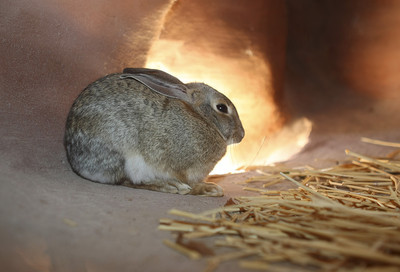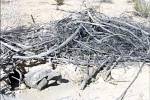Creature Teachers
Name your game: Spot the Phrynosoma platyrhinos? Hide-and-seek with the Heloderma suspectum cinctum? Peekaboo with the Sylvilagus audubonii?
Any reputable sports book would place your odds lower than an Aspidoscelis tigris' belly.
Cagey, these caged creatures -- virtually disappearing into themselves and their man-made bunkers at Springs Preserve as if they patented the concept of hiding in plain sight centuries before nature invented blackjack and surrounded them with modern Las Vegas. When they don't have their snouts and beaks stuck in the air over their snobby Latin surnames, they also go by desert-horned lizard, banded Gila monster, desert cottontail and tiger whiptail lizard, respectively -- but we know you already knew that.
"These animals have been here for thousands of years, and they have adapted to the desert, and we need to follow their example and adapt our own lives," says Jay Nichols, curator of Springs Preserve, home to the Origen Experience, a living, breathing (and hopping, slithering, crawling and hanging upside down) collection of critters that were able to crack the code of desert dwelling naturally long before we created central air conditioning to do likewise.
"Late in the day, they throw themselves beneath the sand or disappear into burrows," says Preserve senior zoologist Thomas O'Toole, explaining their tendency to seemingly vanish within the glass walls of the exhibit. "But early in the day, they're all out sunning themselves."
Just picture a lizard in a revealing bikini and Ray-Bans, sipping one of those tropical-blue umbrella drinks -- no doubt inspired by the GEICO gecko.
"People can learn how the animals survive in the desert, how they beat the heat. They're all really good at hiding, so it's really a challenge to exhibit them in such a way that when people come here, they can see them," O'Toole says, pointing out a couple of spiders lounging nearby, a reminder to his guest that it's time for a monthly home spraying by the pest-control guy.
"Oh man, don't say that!" he moans. But hey -- there's the desert, and then there's your bedroom. Everything in its rightful place, and for a variety of intriguing wildlife, this is that rightful place.
Search, scan and crane your neck to find them, but once you do, they're a testament to nature's extraordinary repertoire. Most of the exhibits are framed in rock formations, and if the stars have gone underground or incognito, there are tiny enclaves beneath the cages to spy their burrows through acrylic, domelike windows.
"It's really popular with the kids," O'Toole says of the tight, low-hung viewing space. Adults should proceed only if they have an orthopedist on speed dial.
Amazingly, though, a banded Gila monster -- which spends 97 percent of its time beneath the surface -- is relaxing within easy eyeshot. A sidewinder snake -- or Crotalus cerastes, if you prefer a formal introduction -- is curled up under a small cliff. You'll have to crouch to glimpse the desert tortoise, locked down in a burrow as a notice on the upper floor of its residence notes, "We went underground for the winter."
There's the strangely named kangaroo rat -- "it's called that mostly because of the way it moves around," O'Toole says, though you wonder if it would look a little cuter hopping around with a rodent-sized pouch and gnashing its teeth through an Aussie accent.
Around the corner is a pocket gopher -- no, you can't clip it to your belt -- and the cuddlier desert cottontails, five of them scurrying to all ends of a pen. Nearby, a gray fox -- Urocyon cinereoargenteus, if you want to be respectful -- is adorably asleep, head tucked into its tail behind a sign that reads, "Please don't tap on the glass -- it hurts my ears!"
And that eerie clicking sound is coming from ... holy bat cave, Batman, it's the tiny Antrozoud pallidus! The little winged fellows are creepy, and oddly irresistible, scrunched into a corner of the viewing glass, dark and brooding. It's all very ... Nosferatu.
"A lot of people think the desert is somewhere out there," Nichols says. "But we live in Las Vegas, and Las Vegas is right in the middle of the desert."
What better place to play hide-and-seek with a Hypsiglena torquata or peekaboo with a Scolopendra polymorpha?
Fine, call them a desert night snake and a banded desert centipede. They're pretty informal around here.
Contact reporter Steve Bornfeld at sbornfeld@reviewjournal.com or (702) 383-0256.
what: The Origen Experience
when: 10 a.m.-6 p.m. daily
where: Las Vegas Springs Preserve, 333 S. Valley View Blvd.
tickets: $6.95-$18.95; children under 5 admitted free (822-8344)



